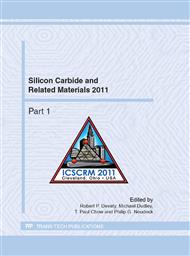[1]
S. Kaciulis, L. Pandolfi, E. Comini, G. Faglia, M. Ferroni, G. Sberveglieri, S. Kandasamy, M. Shafiei, W. Wlodarski, Nanowires of metal oxides for gas sensing applications, Surf. Interface Anal. 40 (2007) 575-578.
DOI: 10.1002/sia.2736
Google Scholar
[2]
T. Baron, M. Gordon, F. Dhalluin, C. Ternon, Si nanowire growth and characterization using a microelectronics-compatible catalyst: PtSi, Appl. Phys. Lett. 89 (2006) 233111-233113.
DOI: 10.1063/1.2402118
Google Scholar
[3]
M. Lin, K.P. Loh, C. Boothroyd, A. Du, Nanocantilevers made of bent silicon carbide nanowire-in-silicon oxide nanocones, Appl. Phys. Lett. 84 (2004) 5388-5390.
DOI: 10.1063/1.1828601
Google Scholar
[4]
K. Zekentes, K. Rogdakis, SiC nanowires: material and devices, J. Phys. D Appl. Phys. 44 (2011) 133001-133017.
DOI: 10.1088/0022-3727/44/13/133001
Google Scholar
[5]
H. Dai, E.W. Wong, Y.Z. Lu, S. Fan, C.M. Lieber, Synthesis and characterization of carbide nanorods, Nature, 375 (1995) 769-772.
DOI: 10.1038/375769a0
Google Scholar
[6]
B.C. Kang, S.B. Lee, J.H. Boo, Growth of beta-SiC nanowires and thin films by metalorganic chemical vapor deposition using dichloromethylvinylsilane, J. Vac. Sci. Technol. B 23 (2005) 1722-1725.
DOI: 10.1116/1.1949221
Google Scholar
[7]
G. Attolini, F. Rossi, M. Bosi, B.E. Watts, G. Salviati, Synthesis and characterization of 3C -SiC nanowires, J. Non-Cryst. Solids 354 (2008) 5227-5229.
DOI: 10.1016/j.jnoncrysol.2008.05.064
Google Scholar
[8]
M.H. Rümmeli, D.B. Adebimpe, E. Borowiak-Palen, T. Gemming, P. Ayala, N. Ioannides, T. Pichler, A. Huczko, S. Cudzilo, M. Knupfer, B. Büchner, Hydrogen activated axial inter-conversion in SiC nanowires, J. Solid State Chem. 182 (2009) 602-607.
DOI: 10.1016/j.jssc.2008.12.004
Google Scholar
[9]
F. Dhalluin, P.J. Desré, M.I. Den Hertog, J.L. Rouvière, P. Ferret, P. Gentile, T. Baron, Critical condition for growth of silicon nanowires, J. Appl. Phys. 102 (2007) 094906-094906-094911.
DOI: 10.1063/1.2811935
Google Scholar
[10]
S. Nakashima, H. Harima, Raman investigation of SiC polytypes, Phys. Status Solidi A 162 (1997) 39-64.
DOI: 10.1002/1521-396x(199707)162:1<39::aid-pssa39>3.0.co;2-l
Google Scholar
[11]
S. Nishino, J.A. Powell, H.A. Will, Production of large-area single-crystal wafers of cubic SiC for semiconductor devices, Appl. Phys. Lett. 42 (1983) 460-462.
DOI: 10.1063/1.93970
Google Scholar
[12]
J.P. Li, A.J. Steckl, Nucleation and void formation mechanisms in SiC thin film growth on Si by carbonization, J Electrochem Soc. 142 (1995) 634-641.
DOI: 10.1149/1.2044113
Google Scholar


